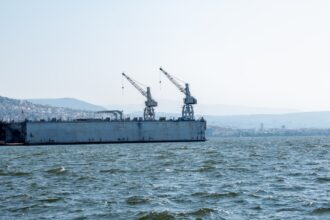The history of U.S. submarines is a fascinating journey that reflects the broader evolution of naval warfare and technology. From their inception in the early 20th century, submarines have undergone significant transformations, adapting to the changing demands of military strategy and technological advancements.
The first U.S. submarines, such as the USS Holland, were relatively primitive vessels, powered by diesel engines and equipped with limited weaponry. However, as World War I approached, the need for more effective underwater combat capabilities became apparent, leading to the development of more sophisticated designs.
By World War II, U.S. submarines had evolved into formidable weapons of war. The fleet boats, particularly the Gato and Balao classes, showcased remarkable advancements in design and technology.
These submarines were capable of long-range patrols and could carry a substantial arsenal of torpedoes. Their effectiveness in disrupting enemy supply lines in the Pacific theater underscored the strategic importance of submarines in modern naval warfare. The post-war era saw further innovations, including the introduction of nuclear-powered submarines, which revolutionized underwater operations by providing virtually unlimited range and endurance.
Key Takeaways
- US submarines have evolved significantly over the years, incorporating advanced technology and design features to enhance their stealth capabilities.
- Stealth is crucial in submarine operations as it allows them to operate undetected, gather intelligence, and carry out strategic missions without being detected by adversaries.
- Advanced technology and design features such as acoustic signature reduction and quiet propulsion systems play a key role in enhancing the stealth capabilities of US submarines.
- The reduction of acoustic signature and the use of quiet propulsion systems are essential in minimizing the detection of US submarines by enemy forces.
- Submarine stealth has a significant impact on national security, providing the US with a strategic advantage and the ability to project power globally while remaining undetected.
The Importance of Stealth in Submarine Operations
Stealth has become a cornerstone of submarine operations, fundamentally altering how naval engagements are conducted. The ability to operate undetected is crucial for submarines, allowing them to gather intelligence, launch surprise attacks, and evade enemy detection. This stealth capability is not merely a tactical advantage; it is a strategic necessity in an era where advanced surveillance technologies are increasingly prevalent.
The effectiveness of a submarine often hinges on its ability to remain hidden from adversaries while executing its mission. The importance of stealth extends beyond mere evasion; it also influences the psychological aspects of warfare. A silent submarine can instill fear in enemy forces, creating uncertainty and hesitation in their operational planning.
This psychological edge can be as valuable as any physical weaponry, as it can deter potential aggressors from taking action. As such, the emphasis on stealth has driven significant investments in research and development aimed at enhancing the covert capabilities of U.S. submarines.
Advanced Technology and Design Features

The integration of advanced technology into submarine design has been pivotal in enhancing their operational capabilities. Modern U.S. submarines are equipped with cutting-edge systems that improve their stealth, navigation, and combat effectiveness.
For instance, advancements in materials science have led to the development of quieter hull designs that minimize noise generation while maximizing hydrodynamic efficiency. These innovations allow submarines to move through the water with reduced acoustic signatures, making them harder to detect. Moreover, sophisticated sonar systems have transformed how submarines engage with their environment.
Modern sonar technology enables submarines to detect and track enemy vessels from great distances while remaining undetected themselves. Additionally, advancements in computer processing power have facilitated real-time data analysis, allowing submarines to make informed decisions quickly during complex operations. These technological enhancements not only improve the effectiveness of individual submarines but also contribute to the overall strength of the U.S.
Navy’s undersea capabilities.
The Role of Acoustic Signature Reduction
| Metrics | Value |
|---|---|
| Reduction in acoustic signature | Up to 80% |
| Effectiveness in stealth operations | High |
| Impact on fuel efficiency | Minimal |
| Cost of implementation | Varies |
Acoustic signature reduction is a critical aspect of submarine design and operation that directly impacts stealth capabilities. Every vessel produces sounds as it moves through water, whether from machinery, propellers, or hull vibrations. These sounds can be detected by enemy sonar systems, making it imperative for submarines to minimize their acoustic signatures.
Engineers have developed various techniques to achieve this goal, including the use of sound-absorbing materials and innovative hull shapes that reduce noise generation. In addition to physical design changes, operational practices also play a role in acoustic signature reduction. Submarines often employ specific maneuvers and operational profiles that minimize noise production during critical phases of their missions.
For example, they may operate at slower speeds or adjust their depth to avoid detection by enemy sonar systems. This combination of advanced engineering and tactical maneuvering allows U.S. submarines to maintain a stealthy profile while executing their missions effectively.
The Use of Quiet Propulsion Systems
Quiet propulsion systems are another vital component of submarine stealth technology. Traditional diesel-electric propulsion systems have been enhanced with advanced technologies that significantly reduce noise levels during operation. Nuclear-powered submarines, such as those in the Virginia class, utilize advanced reactor designs that produce minimal sound while providing sustained power for extended missions.
This quiet operation is essential for maintaining stealth during both offensive and defensive maneuvers. The development of alternative propulsion methods, such as air-independent propulsion (AIP), has further expanded the capabilities of non-nuclear submarines. AIP systems allow submarines to operate submerged for extended periods without surfacing or running their diesel engines, which would generate noise detectable by enemy forces.
By incorporating these quiet propulsion technologies, U.
submarines can enhance their stealth capabilities and remain undetected for longer durations, increasing their effectiveness in various operational scenarios.
The Impact of Submarine Stealth on National Security

The stealth capabilities of U.S. submarines have profound implications for national security. As potential adversaries develop increasingly sophisticated anti-submarine warfare (ASW) technologies, maintaining an edge in stealth becomes essential for deterrence and defense strategies.
The ability to operate undetected allows U.S.
Moreover, submarine stealth contributes to the overall balance of power in global military dynamics.
A robust fleet of stealthy submarines enhances the United States’ ability to project power and respond to threats across various theaters of operation. This capability not only deters potential aggressors but also reassures allies and partners of U.S. commitment to collective security arrangements.
In an era marked by geopolitical tensions and evolving threats, the role of submarine stealth in safeguarding national interests cannot be overstated.
The Challenges of Maintaining Stealth in Underwater Operations
While advancements in technology have significantly improved submarine stealth capabilities, challenges remain in maintaining this critical advantage during underwater operations. One major challenge is the increasing sophistication of enemy ASW systems, which leverage advanced sensors and artificial intelligence to detect and track submarines more effectively than ever before. As adversaries invest in these technologies, U.S.
submarines must continuously adapt their tactics and technologies to counter emerging threats. Environmental factors also pose challenges to maintaining stealth. Underwater acoustics can be influenced by various conditions such as temperature gradients, salinity levels, and ocean currents, which can affect sound propagation and detection ranges.
Submariners must be acutely aware of these factors when planning operations to ensure they remain undetected while navigating complex underwater environments.
Future Developments in Submarine Stealth Technology
Looking ahead, future developments in submarine stealth technology promise to further enhance the capabilities of U.S. submarines. Research into new materials that can absorb or deflect sound waves is ongoing, with potential breakthroughs that could lead to even quieter hull designs.
Additionally, advancements in artificial intelligence may enable more sophisticated sonar systems capable of distinguishing between friendly and hostile vessels with greater accuracy. Moreover, innovations in propulsion technology may yield quieter systems that further reduce acoustic signatures during operation. As nations continue to invest heavily in naval capabilities, the race for superior submarine stealth will likely drive ongoing research and development efforts within the U.S.
Navy and its defense contractors.
The Global Reach of US Submarines
The global reach of U.S. submarines is a testament to their strategic importance in projecting power and influence around the world. With bases strategically located across various regions, U.S.
submarines can operate in diverse theaters, from the Pacific Ocean to the Mediterranean Sea. This global presence allows them to respond rapidly to emerging threats and engage in joint exercises with allied forces. Furthermore, the ability to deploy submarines covertly enhances their effectiveness as deterrents against potential adversaries.
By maintaining a constant undersea presence near critical chokepoints or areas of geopolitical tension, U.S. submarines can deter aggression while providing reassurance to allies concerned about regional stability.
The Strategic Advantage of Silent Submarines
Silent submarines provide a strategic advantage that extends beyond mere evasion; they enable a range of offensive and defensive operations that can shape the outcome of conflicts. Their ability to conduct covert surveillance missions allows for timely intelligence gathering on enemy activities without revealing their presence. This intelligence can inform broader military strategies and operational planning.
In addition to intelligence gathering, silent submarines can launch precision strikes against high-value targets with minimal warning or detection. This capability enhances the element of surprise in military operations, complicating adversaries’ responses and increasing the likelihood of mission success. As such, silent submarines play a crucial role in modern military doctrine by providing commanders with flexible options for engaging threats while minimizing risks.
The Ongoing Importance of Submarine Stealth in Modern Warfare
In conclusion, submarine stealth remains a vital component of modern warfare strategies for the United States Navy and its allies. As technological advancements continue to reshape naval operations, maintaining an edge in stealth capabilities will be essential for ensuring national security and deterring potential adversaries. The evolution of U.S. submarines reflects a commitment to innovation and adaptability in an ever-changing global landscape. As geopolitical tensions persist and new threats emerge, the importance of submarine stealth will only grow in significance. The ability to operate undetected provides not only tactical advantages but also strategic leverage in an increasingly complex world where information dominance is paramount. Thus, as nations invest in their naval capabilities, the ongoing pursuit of submarine stealth technology will remain a critical focus for ensuring maritime security and stability on a global scale.
The stealth capabilities of U.S. submarines have long been a subject of intrigue and technological advancement. One of the key reasons these submarines are so quiet is due to the sophisticated engineering and design that minimizes noise, making them nearly undetectable underwater. For a deeper understanding of the technologies and strategies employed to achieve such stealth, you can explore a related article on this topic by visiting In The War Room. This resource provides insights into the innovations and tactical advantages that contribute to the silent operation of these formidable vessels.
WATCH THIS! America’s Nuclear Navy Was Born From Espionage
FAQs
What makes US submarines so quiet?
US submarines are designed with advanced technology and engineering to minimize noise and acoustic signatures. This includes sound isolation, vibration reduction, and the use of quiet propulsion systems.
How does the US Navy maintain the quietness of its submarines?
The US Navy employs rigorous maintenance and inspection procedures to ensure that submarine systems and components remain in optimal condition, minimizing noise and acoustic emissions.
What role does stealth play in submarine operations?
Stealth is crucial for submarines to operate undetected, allowing them to gather intelligence, conduct surveillance, and carry out strategic missions without being detected by adversaries.
What are some of the specific technologies used to make US submarines quiet?
US submarines utilize advanced sound-dampening materials, precision engineering, and quiet propulsion systems such as nuclear power and advanced electric drive technology to reduce acoustic signatures.
How does the quietness of US submarines compare to those of other countries?
US submarines are widely regarded as some of the quietest in the world, giving them a significant advantage in stealth and operational capabilities compared to submarines from other countries.




